Watching how mountain hunting opportunities have been constantly shrinking around the globe, I have concluded that the time is NOW to take advantage of what is still out there before it all evaporates into thin mountain air. This past year, after finally receiving the unpleasant news of Azerbaijan remaining closed for the third year in a row and knowing that we would be travelling to Spain to visit family for Christmas, I saw the timing right to capitalize on the opportunity and kill two birds with one rock. In other words, hunt for a Gredos Ibex and then visit/wine/dine with the family shortly thereafter.
Many of us mountain hunters become friends with our guides AFTER the hunt. In my case, my friendship with Valeriano Bellés started before we even hunted together. This has been a 12-year mutual friendship with a helping hand extended both ways and mostly outside the realm of hunting. For example, when my wife was walking some tricky sections of the Camino de Santiago, I could trust her safety only with Vale. In his case, when he showed up with a client for a Goat hunt in BC and his client’s gear didn’t arrive, he knew who to turn to. Now to the Ibex…
The conservation story of the Gredos ibex ranks as one of the almost “fairy tale” stories of recent times. Let’s first discuss this success story as well as some other important taxonomy and behavioral markers.
Gredos Ibex is a regal game animal that has been hunted for several centuries primarily by the Spanish and Portuguese nobility until 1905 when the populations were reduced to only ONE adult male, seven females, and four lambs. The dire situation caused King Alfonso XIII to declare a large part of the Gredos mountains as a protected area. Incidentally, the scientific name for this Ibex (Capra pyrenaica victoriae) was coined to honor Queen Victoria Eugenia who was King Alfonso’s wife when the declaration took place and one that was very passionate about saving this Ibex.
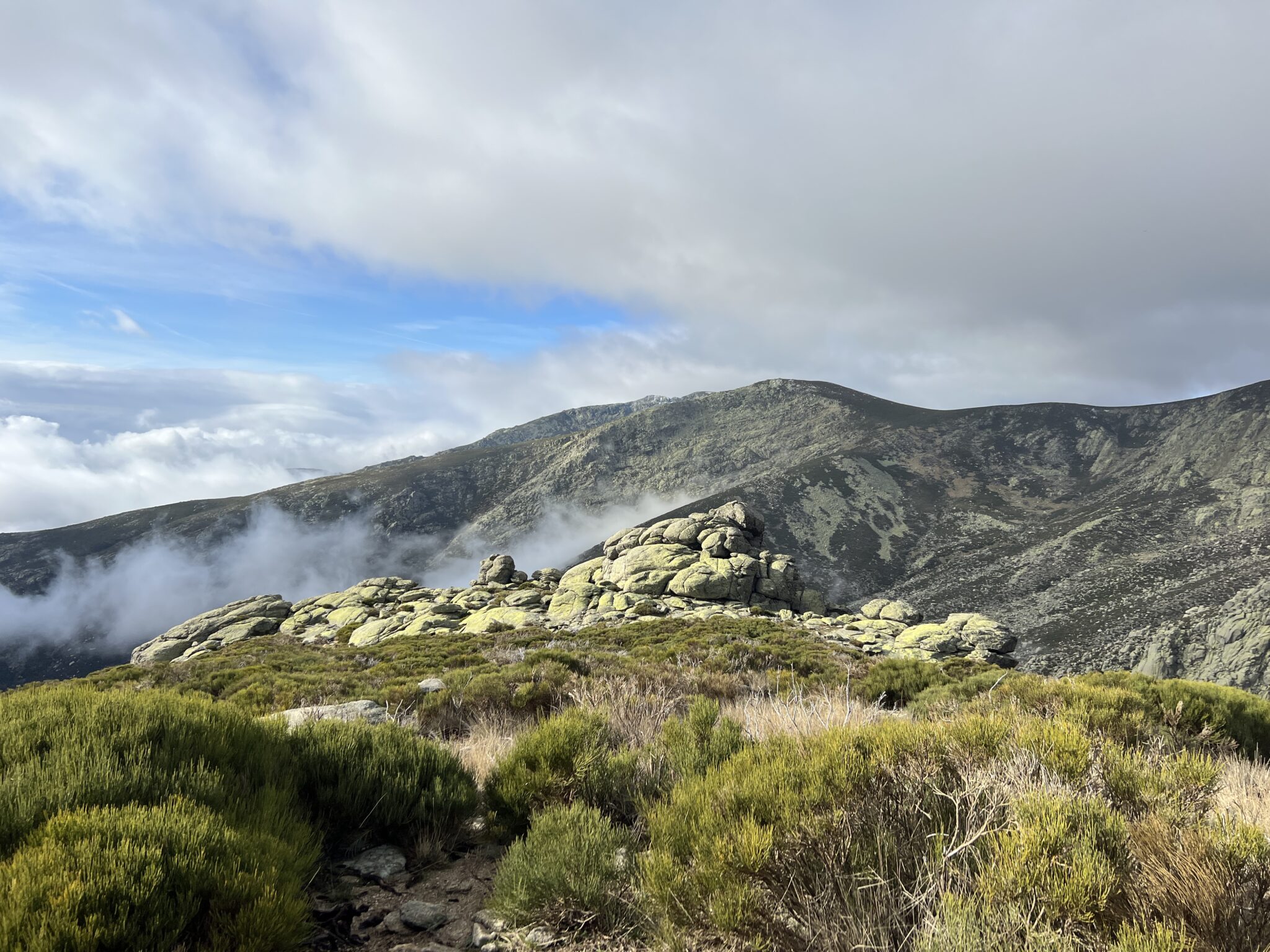
The Gredos mountains are a mountain hunter and a hiker’s paradise. I will return someday to summit its highest peak “Pico Almanzor”.
Besides the protection offered by several Spanish and other organizations, the systematic annihilation of their predators has contributed to their population growth. In some areas, they are even considered agricultural pests! They browse as well as graze depending on food availability. Males do not generally live past 16 years. The oldest recorded specimen was a female aged at twenty. Males past twelve years of age have a grizzled look and often carry scars of battle. Shoulder height on an average male is about 42 inches, body weight approximately 200 lbs, and tail length is about 5”. All males carry a beard.
The horns on the males are heavy, corrugated, and much longer than those on the females. They typically grow upwards in an outward direction, then backward and inward in a heteronymous twist. Each horn has the opposite spiral (left horn right spiral etc..) with a weak front keel and a sharp posterior keel. The male’s age can be accurately estimated by counting the growth annuli.
Their rut starts in November and lasts until the end of December with a strict hierarchy of dominant males observed during the rut. The gestation period for females is around 5 months and typically one kid is born.
The trophy method of measurement is adopted from CIC (Center International de Chasse). Typically, an Ibex with a score of 204 points or lower is considered a representative, 205-215 is a Bronze, 216-225 a silver, 226-230 a gold, and anything above are considered grand prix. The current world record scores a whopping 311 CIC points and came from La Umbria.
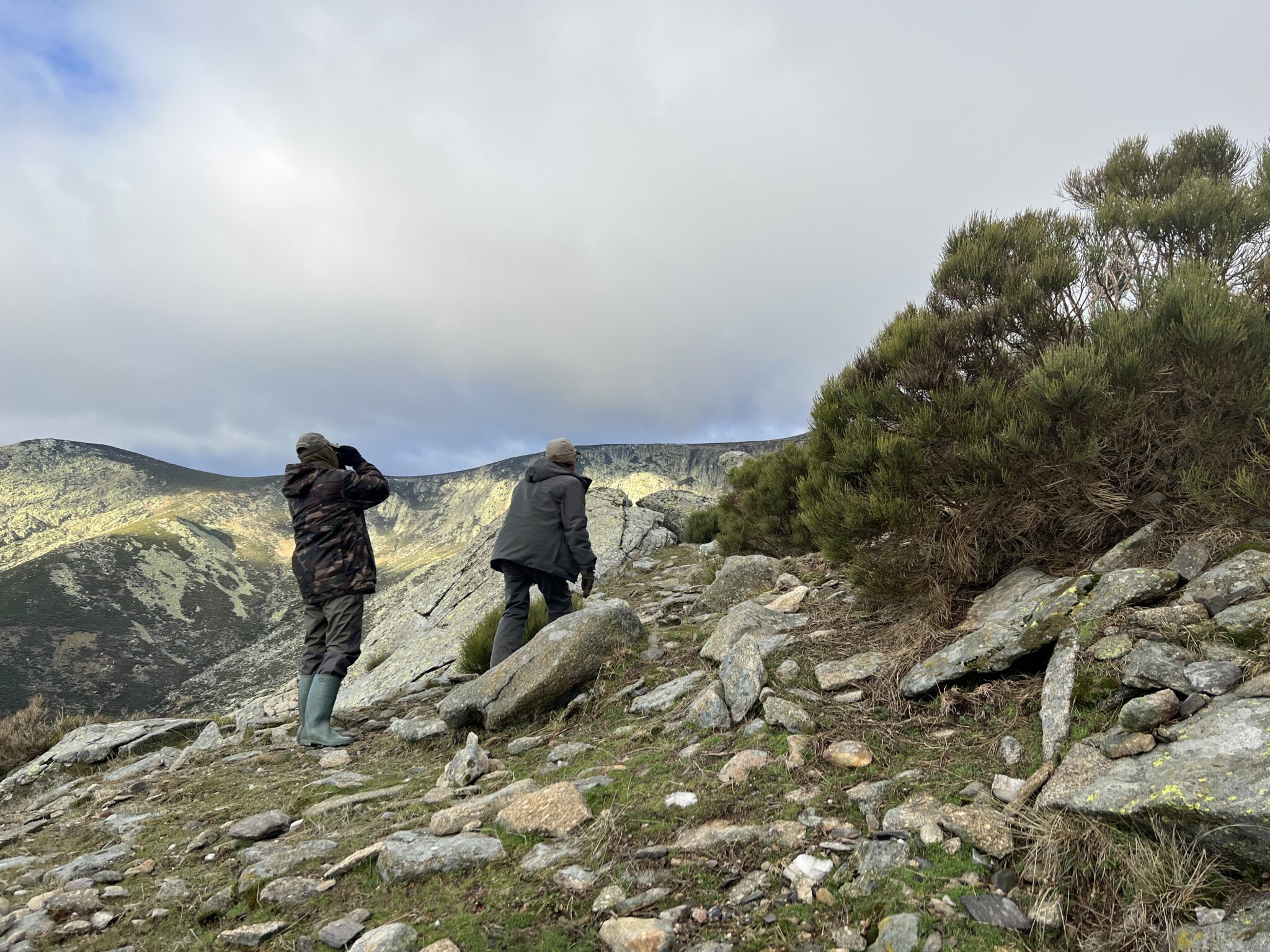
Here is where spotted the “Solstice” Billy…
The estimated population of the Gredos Ibex is around 15,000 individuals and its hunt has been transformed into a powerful economic engine, benefiting guides, outfitters, local communities, and the Spanish government. The cull quotas are around 2% annually (roughly 300 animals which include a few selected dry nannies as well) which is extremely low and according to some outsiders, can lead to an imbalanced age pyramid.
Now to my hunt…it wasn’t until early November 2022 that I finally received the confirmation from Vale that he had obtained and set aside one of the last licenses for the Gredos reserve and I was in jubilation shortly thereafter. Having harvested a mature Aoudad in Texas in early October and with the Ibex hunt looming in December, I dedicated my entire November here at home in Alberta to guide and help my sons and several friends to fill their freezers without pulling the trigger myself.
As a side note, my younger offspring Miguel was finishing school early (mid-December) and decided to join pops for this once in a lifetime opportunity. Miguel is a child that in Spanish we refer to as enmantillado which translates to someone that is born with uber blessings. On any hunt that Miguel shows up, good luck is never far away! Having been jazzed with this news, I secretly reached out to Vale to see if he could also secure a tag for a dry Nanny for Miguel. More on that later….
The two-leg transatlantic flight from Calgary landed at Madrid’s Barajas airport where Vale was waiting for us in the lobby. After the usual hugs and handshakes, we hopped in his Nissan to travel West for three hours to the small town of Madrigal de la vera. It had been raining nonstop for two weeks and with our hunt slated for only three days, I was a tad worried. We checked into a modest hotel which Vale had pre-arranged before our arrival and the Alhambra restaurant just across the street was to provide all our meals. Vale also called the game warden to alert him of our arrival and make plans for the day after.
This area of Spain is famous for the Spanish Pata Negra pigs which produce the absolute best cured ham in the world. We sampled some as well as a steak from this animal’s upper shoulder called Albanico Iberico. Alas, this was the absolute best cut of pork I had ever tasted. I learned early that on all my international hunting trips where time is of the essence, I should take sleeping pills to reset my clock faster and this time was no exception.
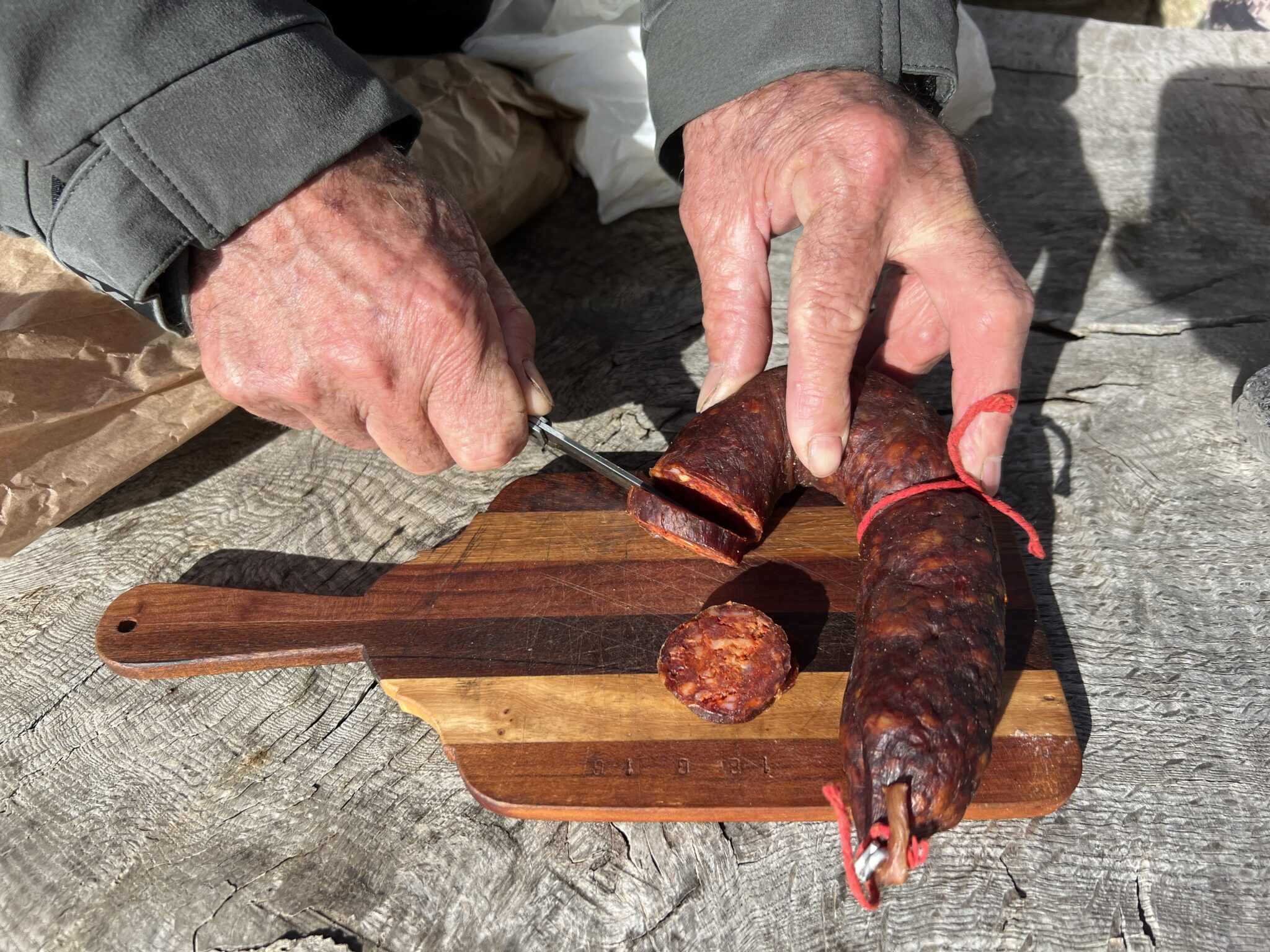
Ahhh…nothing quite like the homemade Spanish Chorizo….
The next morning, a couple of glasses of café con leche accompanied by a simple tostado was enough to jump-start our engines and allow us to eagerly start our hunt. We drove a tiny uphill road out of town, meandering through small homesteads and farms, crossed the locked gates of the Gredos reserve, and parked the truck. To avoid the hassles of bringing my rifle over across the pond, I was to use Vale’s Sauer rifle chambered in the classic 7×64 Brenneke European cartridge. Both Miguel and I fired one shot which incidentally overlapped and confirmed the rifle’s zero. Miguel inquired as to why he was asked to shoot the rifle and with a serious face, we all told him that wild pigs are a menace to the landscape here and he will be asked to shoot them if we were to see any. The two wardens arrived shortly and off we went looking for a mature Billy.
My license was for a representative Billy which had to score under 204 CIC points. Frankly, I could care less about the score but instead wanted an old specimen. This was clearly communicated to the game wardens as I speak fluent Spanish, being married to a Spaniard. In the meantime, we had risen above the fog and the clouds that had filled the valley floors were below us. The landscape was gorgeous with pre-Cambrian limestone, a myriad of vegetation, and no trees. The grass was abundant and thankfully no snow was on the ground. The air smelled like spiced wine, and we were completely immersed in our game-rich piece of paradise. We glassed and found a group of Ibex but there was only a gold medal and a few young Billies amongst them. We climbed further up, continuously stopping and glassing the drainages that would appear one after the other in front of us.
Finally, around noon, we saw a herd of roughly 30 Ibex and after a close examination, I saw the exact specimen I had come all the way here to harvest. An old mature Billy with a grizzled coat and chipped horns. One that I would be proud to shoot and display on my wall. The wind was also in our favor. We put a stalk on the group which was calmly feeding and unaware of our presence. Finally peeking over a small knob, we saw them 220 paces away. The Billy I was after was with two Nannies and I laid down behind the Sauer to prepare for the shot. The instant he cleared the Nannies, I sent the 140-grain Nosler spitzer towards his shoulder and he tipped over sideways where he stood.
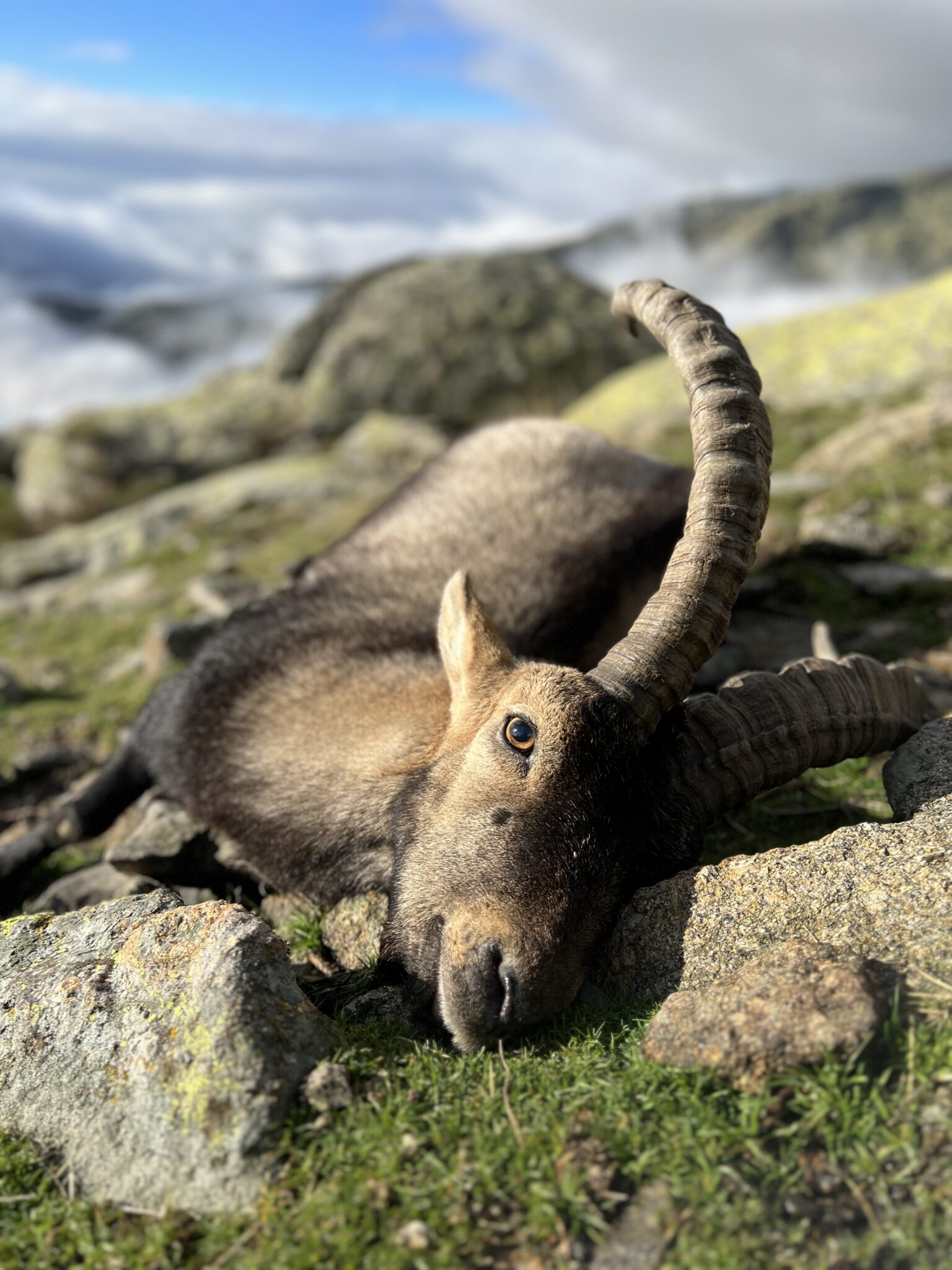
The 12-year-old “Solstice” Billy was selectively taken out of the herd for proper herd management.
The whole entourage including myself was in jubilation and we covered the 220-yard distance in no time to my Billy. He was a superb specimen and the wardens aged him at twelve years. What a joy to be able to remove an older male – past his prime – from the population, eh? I was walking on cloud nine and even more jazzed as Miguel was with me to experience the magic of mountain hunting. As I expressed my reverence for this creature, I administered a short prayer to the good Lord for this blessing, did a couple of short spiels, and took many a photo. Because the game department is interested in blood, pancreas, and other genetic samples, we didn’t gut the Billy and instead dragged him to the main trail some 300 yards below where we could retrieve the truck and load him up later. The date was Dec 21st, the Winter solstice, ergo the title!
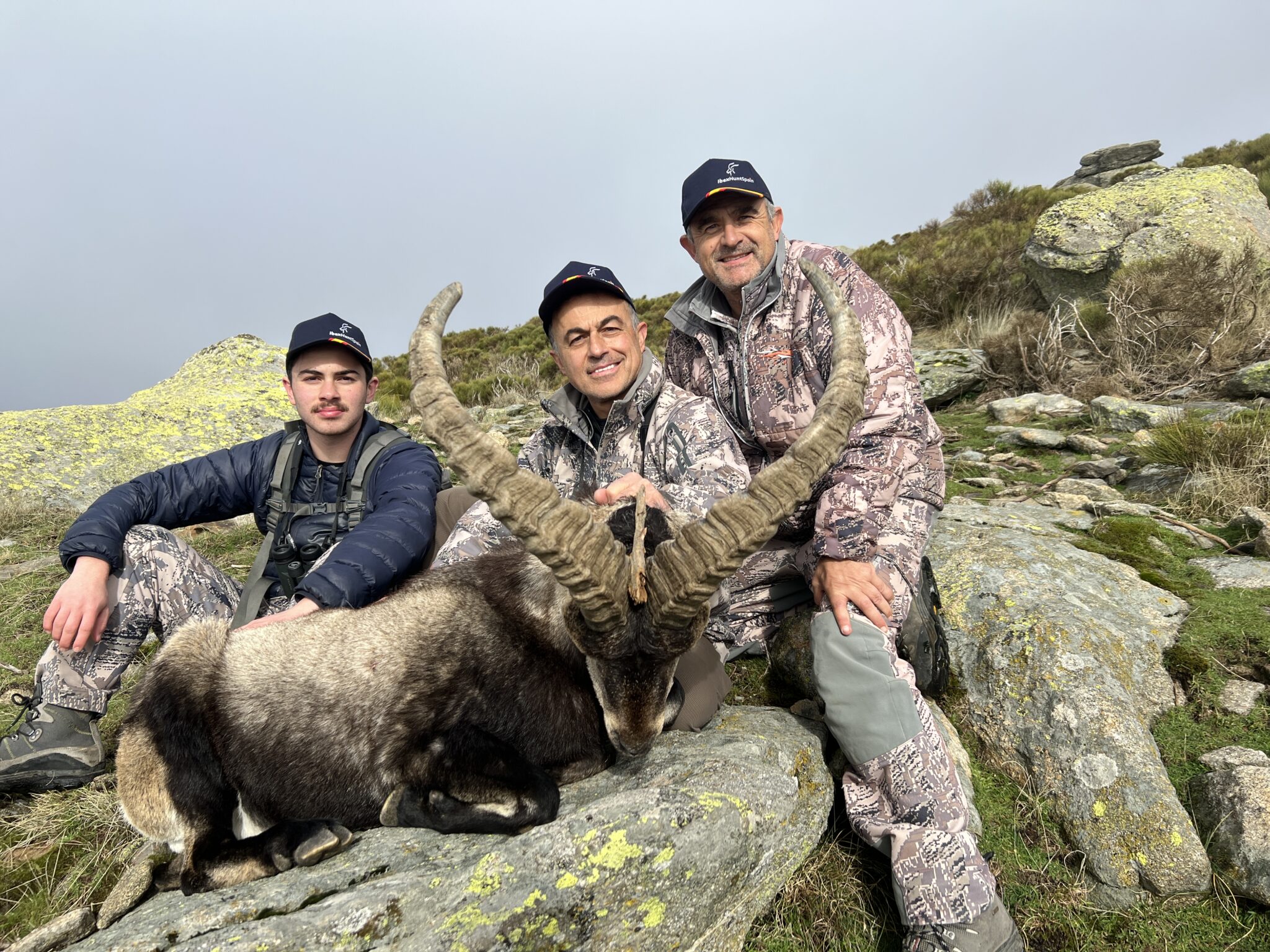
A heartfelt thank you to my buddy Vale for bringing this dream to reality. Note the corrugated keeled horns, the broomed tips, and the grizzled coat of this magnificent European trophy.
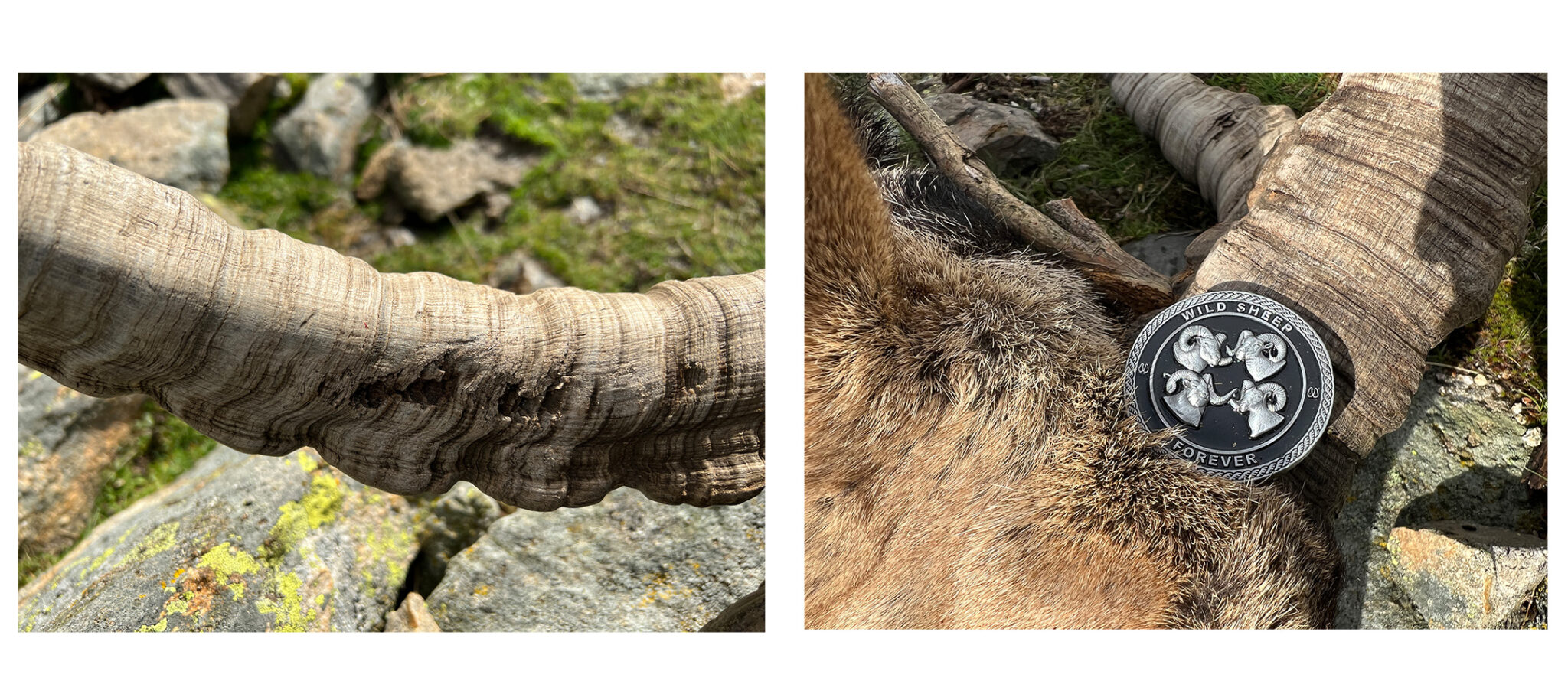
Age before size or beauty, every time!
It is now appropriate to talk about the rest of the hunt. Precisely three days prior to our arrival, Vale had sent me a message via WhatsApp that he was able to also secure a tag for an old Nanny. The Nanny had to be dry and be a minimum of 12 years old. Neither of us relayed this piece of good news to Miguel as we wanted it to be a surprise. To cover our bases, after we had killed my Billy, Miguel was asking me how come we are not going back to town. I explained to him that since the weather was somewhat clear and the wardens are already up here, they want to conduct game surveys for their annual count while in reality, we were all looking for an old Nanny for him. Hitherto, Miguel was under the impression that we were only looking for wild boar.
The search for an old Nanny continued up the mountain where we saw at least two more groups of Ibex, but none had a Nanny that would fit the bill. We descended somewhat lower and right next to a shepherd hut which in Spain is referred to as la Choza we decided to have our lunch. The wardens had brought locally made Chorizo, cheese, and even wine which we all shared and enjoyed. With a warm head fired by the wine, Vale also told us about how impressed Ernest Hemingway had been when he had hunted in these same mountains and how his novel “For whom the bell tolls” was inspired by the events that had taken place right here while he lived in Spain.

The group that held Miguel’s 13-year-old La Machorra… Not as large as the Billy’s horns but just as majestic in its own right
Around 3 o’clock in the afternoon, we noticed that the fog was starting to rise towards the peaks and suddenly, a lone Billy appeared below us some 400 yards away. While Miguel and Vale stayed behind, the wardens and I made a detour to see what else is with him, and sure enough, amongst a group of seven or eight animals was a dry Nanny standing somewhat to the side. They were exactly 210 yards away chewing their cud below us.
I quickly returned and brought back Miguel and Vale. It was at this point that we had to break our silence and tell Miguel what was going on. He was gob smacked but held it together pretty well. I quickly took a photo of the game with my cell phone, enlarged it, and showed Miguel which Nanny was the correct one for him to shoot. He understood positively and with calm nerves, touched off a shot that killed the Nanny where she stood. Oh my…were we all ever joyful for what had just transpired. After getting to the Nanny which required some careful navigating through some slippery rocks, we confirmed that she was a dry Nanny and one that had never bred (La Machorra in Spanish). How wonderful!
We all hugged Miguel, took photographs, and acknowledged how blessed we had been in just one day with the weather, the game we were after, and the company. This time around, the wardens gutted the Nanny, tied her hooves with a rope and Miguel carried her up the mountain to a main trail that would allow us to walk and retrieve the truck. Just as we loaded her in the truck, the entire area was immersed in thick fog which reminded us of our golden luck.
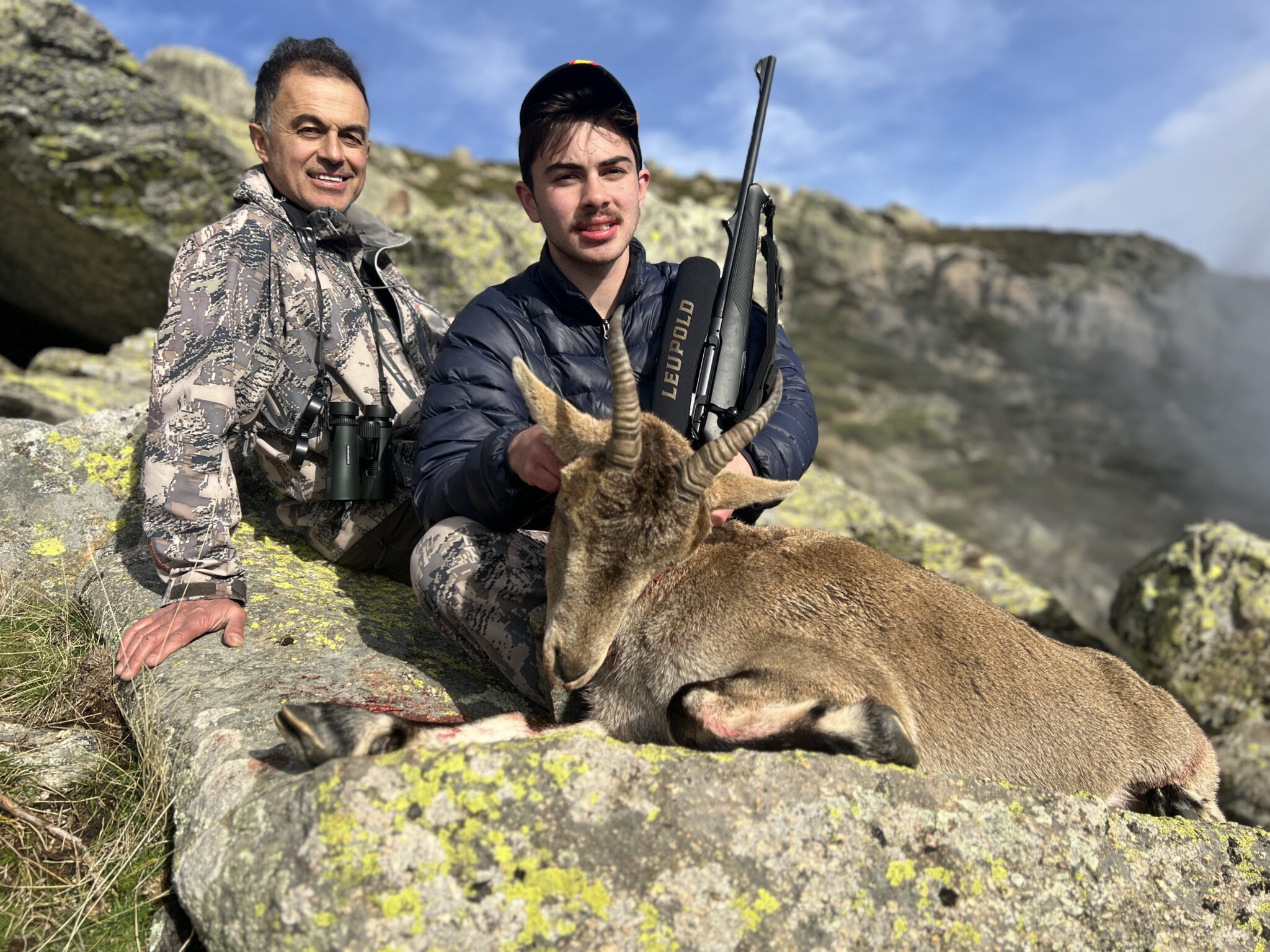
Miguel was speechless when he was asked to take this old Nanny…
After returning to the village around 6 pm, the wardens took their samples and started the caping process for our specimens. I was to have a shoulder mount for my Billy and Miguel a European skull mount for his Nanny. We then returned to our accommodations and after a great supper which included the tenderloins of both animals, celebrated our success over a glass of a hearty Rioja. What a day and what a hunt. That night, I had the sleep of the dead as our hunt had been fruitful in such a short time and in every possible way.
The next day, we met up with the wardens after breakfast, collected our cape/skull/horns, and said goodbye to all of them. I had arranged with Vale that if our hunt was to end early, he would drive us to the little town of Los Yebenes near Toledo where we could visit the hunting museum of Garoz. This was a productive visit, and we were extremely impressed with their museum. They have made displays of all the hunting schemes that are exercised by the Spaniards over many generations and their showroom boasts a mammal and bird collection second to none. I also had planned to purchase one of their beautiful pieces of artwork, sketched by Ramon Garoz of the entire mountain game of the world which I have now framed and hung in my man’s cave.
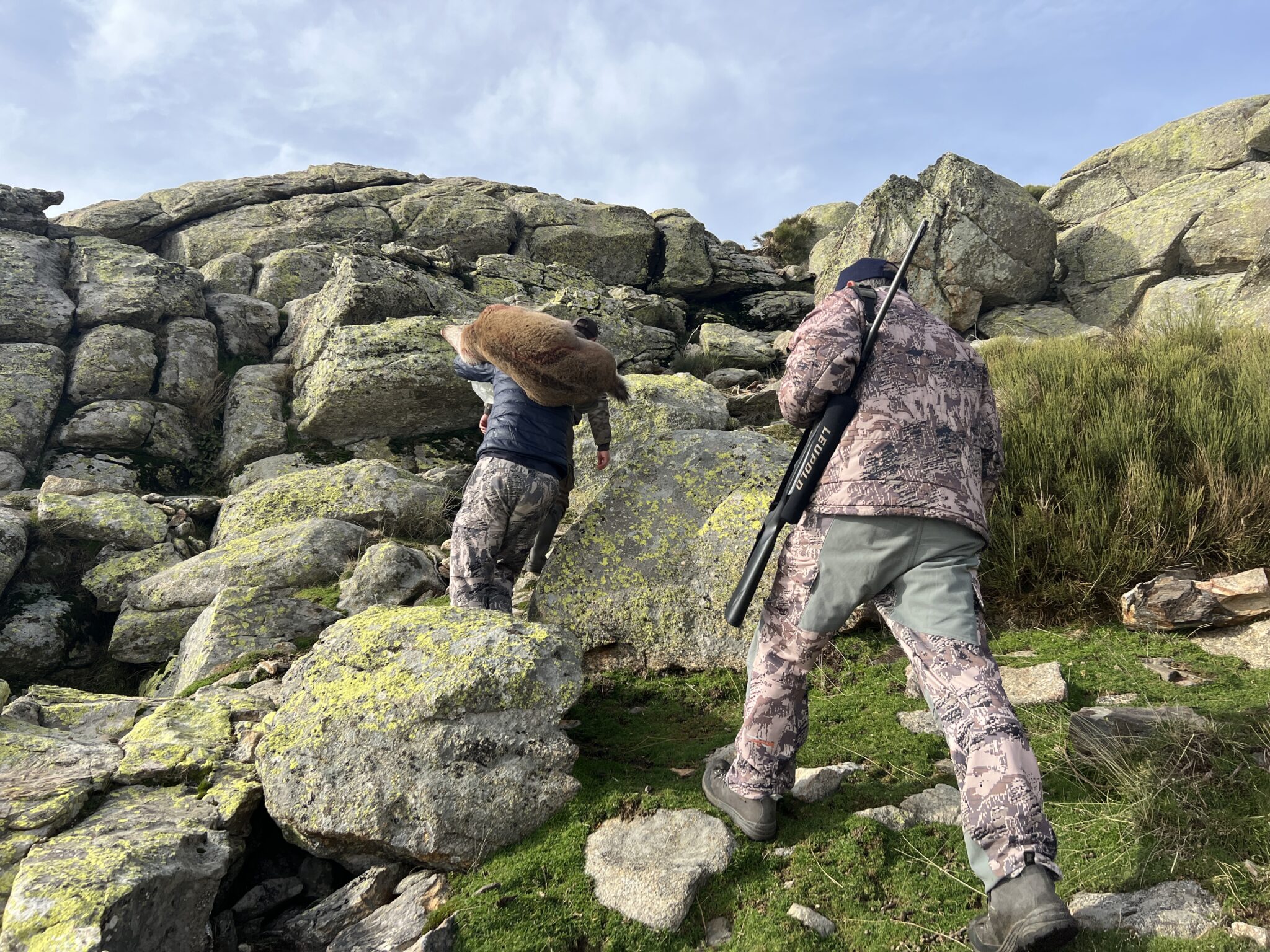
Miguel carrying his quarry up the mountain, the European way…
We then had a leisurely lunch in a bodega nearby and shortly after, Vale dropped us in front of our hotel in the city of Toledo. It was hard to say goodbye as both Miguel and I were in deep appreciation of how Vale was able to get all of this organized on short notice. It didn’t end there as he took our cape/skull/horns to his taxidermist Alfredo and in just 5 short days, the cleaned-boiled skull/horns and semi-tanned cape with the proper paperwork arrived at my mother-in-law’s apartment in Northern Spain. This type of service is unheard of and even though Vale and I are close friends, I know he treats all his clients in this same manner. As his website accurately says: “The taste of professionals”.
This had been a relatively easy hunt compared to some of the places I have hunted in Asia and North America but just as rewarding and culturally rich at the same time. Just before saying goodbye to Vale and as we were hugging each other, I whispered in Vale’s ears that I am yet to get my fourth Spanish trophy; a Pyrenean Chamois, and he smiled. I am hopeful that the good Lord continues to send his blessings my way and that Vale and I can someday scale the peaks of the Pyrenees in search of a mature Rebeco. Until that day, keep your back to the sun, the wind in your face, and your rifle in shipshape!

